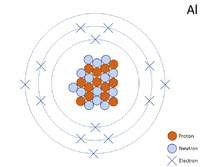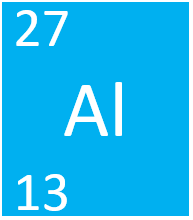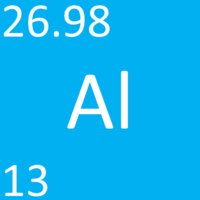Aluminium
Contents
Key Stage 2
Meaning
Key Stage 3
Meaning
Aluminium is a Group 3 metal element, on the Periodic Table, with an atomic number of 13.
About Aluminium
Molecular Structure
- Aluminium has the chemical symbol Al.
- Aluminium atoms join together in large numbers to form a giant metal molecule.
Atomic Structure
- Aluminium as 13 protons and 14 neutrons in its nucleus giving it an Atomic Number of 13 and an atomic mass of 27.
- Aluminium is in Period 3 of the Periodic Table because it has 3 electron shells.
Properties
- Aluminium is a metal element so it is a good thermal conductor and a good electrical conductor.
- Aluminium is a shiny solid at room temperature.
- Aluminium is malleable.
- Aluminium is sonorous.
- Aluminium is ductile.
Key Stage 4

A 2 dimensional representation of the Bohr Model of a Aluminium-27 isotope with 13 protons and 14 neutrons in the nucleus and 2 electrons in the first shell, 8 in the second and 3 in the outer shell.
Meaning
Aluminium is a Group 3 metal element, on the Periodic Table, with 13 protons in the nucleus.
About Aluminium
Molecular Structure
- Aluminium has the chemical formula Al.
- Aluminium atoms join together in a giant metallic structure.
Atomic Structure
- The most stable isotope of Aluminium has 14 neutrons in its nucleus giving it an atomic mass of 27.
- Aluminium is in Period 3 of the Periodic Table because it has 3 electron shells.
- Aluminium loses electrons to form positive metal ions.
Properties
- Aluminium forms ionic bonds with non-metals.
- Aluminium is a metal element so it is a good thermal conductor and a good electrical conductor.
- Aluminium is a shiny solid at standard temperature and pressure and has a high melting point.
- Aluminium is malleable.
- Aluminium is sonorous.
- Aluminium is ductile.
References
AQA
- Aluminium foil, page 32, GCSE Physics; Third Edition, Oxford University Press, AQA'
- Aluminium, extraction from ore, pages 220-1, GCSE Combined Science Trilogy 1, Hodder, AQA'
- Aluminium, extraction of, page 119, GCSE Chemistry, Hodder, AQA'
- Aluminium, page 144, GCSE Combined Science Trilogy; Chemistry, CGP, AQA'
- Aluminium, pages 106-107, 216, 222, GCSE Chemistry; Third Edition, Oxford University Press, AQA'
- Aluminium, pages 169, 286, 287, GCSE Chemistry, CGP, AQA'
- Aluminium, pages 26, 36, 79, 133, 158, 339-41, GCSE Chemistry; Student Book, Collins, AQA'
- Aluminium; extraction by electrolysis, page 158-9, GCSE Chemistry; Student Book, Collins, AQA'
- Aluminium; ore, page 133, GCSE Chemistry; Student Book, Collins, AQA'
- Aluminium; oxide, pages 133, 158-9, 269, GCSE Chemistry; Student Book, Collins, AQA'
- Aluminium; recycling, page 158, GCSE Chemistry; Student Book, Collins, AQA'

